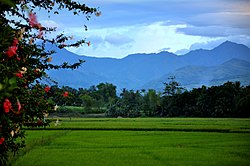Isabela, Negros Occidental
Municipality in Negros Occidental, Philippines From Wikipedia, the free encyclopedia
Isabela, officially the Municipality of Isabela, is a municipality in the province of Negros Occidental, Philippines. According to the 2020 census, it has a population of 64,516 people.[3]
Isabela | |
|---|---|
| Municipality of Isabela | |
 Barangay Camangcamang with Mabinay Mountains seen in the distance | |
| Nickname: The Sweet Heart of Negros | |
 Map of Negros Occidental with Isabela highlighted | |
Location within the Philippines | |
| Coordinates: 10°12′N 122°59′E | |
| Country | Philippines |
| Region | Negros Island Region |
| Province | Negros Occidental |
| District | 5th district |
| Named after | Isabella II of Spain |
| Barangays | 30 (see Barangays) |
| Government | |
| • Type | Sangguniang Bayan |
| • Mayor | Irene C. Montilla |
| • Vice Mayor | Juan Miguel C. Montilla |
| • Representative | Emilio Bernardino L. Yulo III |
| • Municipal Council | Members |
| • Electorate | 41,301 voters (2022) |
| Area | |
• Total | 178.76 km2 (69.02 sq mi) |
| Elevation | 52 m (171 ft) |
| Highest elevation | 651 m (2,136 ft) |
| Lowest elevation | 12 m (39 ft) |
| Population (2020 census)[3] | |
• Total | 64,516 |
| • Density | 360/km2 (930/sq mi) |
| • Households | 15,685 |
| Economy | |
| • Income class | 2nd municipal income class |
| • Poverty incidence | 23.96 |
| • Revenue | ₱ 285.9 million (2022) |
| • Assets | ₱ 473.8 million (2022) |
| • Expenditure | ₱ 228 million (2022) |
| • Liabilities | ₱ 86.09 million (2022) |
| Service provider | |
| • Electricity | Negros Occidental Electric Cooperative (NOCECO) |
| Time zone | UTC+8 (PST) |
| ZIP code | 6128 |
| PSGC | |
| IDD : area code | +63 (0)34 |
| Native languages | Hiligaynon Ati Tagalog |
| Website | www |
Isabela is known for BISCOM (Binalbagan Isabela Sugar Company) located in nearby Binalbagan town.
History
In 1951, the barrios of Magallon, Odiong, and Guinpanaan were separated from Isabela and formed into the town of Magallon (now Moises Padilla).[5]
Geography
Summarize
Perspective
Isabela is 80 kilometres (50 mi) from Bacolod (via La Castellana) or 71 kilometres (44 mi) (via Hinigaran), 35 kilometres (22 mi) from Guihulngan, 14 kilometres (8.7 mi) from Binalbagan, and 19 kilometres (12 mi) from Hinigaran.
Barangays
Isabela is politically subdivided into 30 barangays. Each barangay consists of puroks and some have sitios.
- Amin
- Banogbanog
- Bulad
- Bungahin
- Cabcab
- Camangcamang
- Camp Clark
- Cansalongon
- Guintubhan
- Libas
- Limalima
- Makilignit
- Mansablay
- Maytubig
- Panaquiao
- Barangay 1 (Poblacion)
- Barangay 2 (Poblacion)
- Barangay 3 (Poblacion)
- Barangay 4 (Poblacion)
- Barangay 5 (Poblacion)
- Barangay 6 (Poblacion)
- Barangay 7 (Poblacion)
- Barangay 8 (Poblacion)
- Barangay 9 (Poblacion)
- Riverside
- Rumirang
- San Agustin
- Sebucawan
- Sikatuna
- Tinongan
Climate
| Climate data for Isabela, Negros Occidental | |||||||||||||
|---|---|---|---|---|---|---|---|---|---|---|---|---|---|
| Month | Jan | Feb | Mar | Apr | May | Jun | Jul | Aug | Sep | Oct | Nov | Dec | Year |
| Mean daily maximum °C (°F) | 30 (86) |
31 (88) |
32 (90) |
33 (91) |
32 (90) |
30 (86) |
29 (84) |
29 (84) |
29 (84) |
29 (84) |
30 (86) |
30 (86) |
30 (87) |
| Mean daily minimum °C (°F) | 22 (72) |
22 (72) |
22 (72) |
24 (75) |
25 (77) |
25 (77) |
25 (77) |
24 (75) |
24 (75) |
24 (75) |
23 (73) |
23 (73) |
24 (74) |
| Average precipitation mm (inches) | 38 (1.5) |
29 (1.1) |
55 (2.2) |
65 (2.6) |
141 (5.6) |
210 (8.3) |
212 (8.3) |
176 (6.9) |
180 (7.1) |
180 (7.1) |
130 (5.1) |
70 (2.8) |
1,486 (58.6) |
| Average rainy days | 9.0 | 7.2 | 11.1 | 13.5 | 25.6 | 28.4 | 28.9 | 27.3 | 26.9 | 27.7 | 21.8 | 13.8 | 241.2 |
| Source: Meteoblue (modeled/calculated data, not measured locally)[6] | |||||||||||||
Demographics
|
| |||||||||||||||||||||||||||||||||||||||||||||||||||
| Source: Philippine Statistics Authority[7][8][9][10] | ||||||||||||||||||||||||||||||||||||||||||||||||||||
Economy
Poverty incidence of Isabela
10
20
30
40
50
60
2000
59.48 2003
43.56 2006
36.10 2009
33.84 2012
27.30 2015
26.84 2018
28.00 2021
23.96 Source: Philippine Statistics Authority[11][12][13][14][15][16][17][18] |
Festival
"Tigkalagkalag" is celebrated on the evening of Nov. 2 every year in the town of Isabela.[19] The Pana-ad victory of Tigkalagkalag (Kalag-Kalag) festival is expected to boost the attraction of this unique festival that began in Purok Manacup beside the public cemetery in Isabela town where people would have fun during the night of All Souls Day that was capped with a beauty pageant called Search for the White Lady, this is the same of San Juan Balete Drive {Lost Soul}. It spun off into the municipal festival under former Mayor Renato Malabor, when the town was searching for a festival that was going to be its tourism plank.
Tigkalalag festival of Isabela turned what otherwise are morbid concepts of coffins, candelabras and crashing tombs into a whimsical, tightly designed, skillfully-choreographed presentation that sent it howling to success in yearly competition of all the festivals of Negros Occidental. Tigkalalag is Hiligaynon for All Souls' Day.
Notable personalities
- Lt. Cesar Basa, World War II pilot and hero. First Filipino aviator killed during aerial combat.
- Allan K., actor-comedian/TV host/entrepreneur
References
External links
Wikiwand - on
Seamless Wikipedia browsing. On steroids.



